Ijraset Journal For Research in Applied Science and Engineering Technology
- Home / Ijraset
- On This Page
- Abstract
- Introduction
- Conclusion
- References
- Copyright
Effect of Wood Ash on salt Crystallization and Rapid Chloride Permeability Test (RPCT) in Mortar
Authors: Shivangi ., Varun Kumar Sikka, Ajit Singh, Rahul Gupta
DOI Link: https://doi.org/10.22214/ijraset.2023.54869
Certificate: View Certificate
Abstract
Ash by-products obtained from combustion of wood biomass are generally used in land filling for embankments, road/highway construction. It can be used as soil supplementing material to reduce the alkalinity of soil in agricultural lands. And it can also be used as raw material in the manufacturing of cement in cement industries. Many researches had been carried out to incorporate wood waste ash as a cement replacement material in the production of greener construction material (concrete/mortar) and also as a sustainable means of disposal for wood waste ash. Results of these researches indicated that wood waste ash can be effectively used as a cement replacement material for the production of structural concrete/mortar of acceptable strength and durability parameters. In the present study salt crystallization, rapid chloride permeability test are performed. The results shows As wood ash contains more amount of calcium oxides which are soluble in water and leached out and further react with sodium sulphate. That is why, on increasing the percentage of wood ash, loss in weight as well as loss in compressive strength and chloride ion permeability is high in all the cases but as we increase the percentage of wood ash, chloride ion permeability decreases.
Introduction
I. INTRODUCTION
Ash by-products obtained from combustion of wood biomass are generally used in land filling for embankments, road/highway construction. It can be used as soil supplementing material to reduce the alkalinity of soil in agricultural lands[1]. And it can also be used as raw material in the manufacturing of cement in cement industries. As par current situation, approximately 70% of wood ash produced is managed by land filling, 20% of total wood ash produced is used as a soil supplement material for agricultural activity and the remaining 10% is implemented for other/miscellaneous applications as metal recovery and pollution control[2,3]. Researchers have conducted tests which showed effective results that wood ash can be suitably used to replace cement partially in concrete production [18,17]. Hence, usage of wood ash as replacement for cement is beneficial for the environmental point of view as well as producing low cost construction entity thus leading to a sustainable relationship[20,18]. The main objective of this report is to find out optimum amount of wood ash in cement mortar And effect of wood ash on mortar strength and durability properties [4, 5]. Nehdi and Hayek (2008) studied the effect of sulphate attack on normal Portland cement (NPC) and sulphate-resistant Portland cement (SRPC) mortars. Mortars were prepared by replacing cement as partial replacement by 25% fly ash (FA), 8% silica fume (SF) and 8% diatomaceous earth (DE)[6,7]. Cement and sand ratio was taken as 1:2 and 5cm cubes were made. Curing was done for 28 days. The performance of mortar is monitored for 24 weeks. The performance was noted in the form of weight loss in the sample day by day after immersion in 5% solution of Na2SO4 and in the solution of 5% MgSO4 and in the form of reduction of compressive strength in comparison to mixture which was not immersed in the sulphate solution[8]. Loss in compressive strength is shown in fig
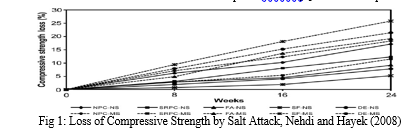
Higher reduction in compressive strength in NPC mortar was noted followed by SRPS and FA after 24 weeks. It is clear from the fig that strength is lower in blended mortars as compared to neat mortar [9]. This is because of reduction in the quantity of calcium hydroxide (CH) and tri calcium aluminate (C3A). CH is the most vulnerable substance which is affected by Na2SO4 to a most.
Haynes et al. (2008) studied the effect of 10% Na2SO4 with temperature and humidity cycles on concrete mix made with Portland cement. They concluded that concrete scaling occurs at the surfaces when sample is immersed in solution of sulphate and it is significant when repeative cycles are applied[2,5].
Similarly, Horsakulthai et al. (2011) studied the effect of finely ground ash obtained from combustion of wood, rice husk ash, sugarcane bagasse waste (BRWA) as partial replacement of cement on chloride permeability of concrete[9,11]. They used replacement percentages as 0%, 10%, 20%, 30% and 40% of total cement content by weight. It was concluded that incorporation of wood ash enhanced the chloride permeability.
However, Wang et al. (2008) studied the chloride permeability on concrete mixture with partial replacement of wood/coal ash, wood fly ash. Level of cement replacement kept constant at 25%. Various types of ash was used like ash from combustion of wood, fly ash of class C type and class F type and coal ash is also blended with these[21]. They performed the rapid chloride permeability test after 56 days of curing. Test was performed in accordance with ASTM C 1202-1991. Based on their experimental work, they concluded that level of 25% replacement level did not result in considerable effect on chloride permeability property of concrete. they also concluded that there was a decrease in chloride permeability when cement is replaced by different wood ashes as compared to pure OPC mixture [15].
Vishwakarma V. et al. (2015) studied the porosity results of concrete made by OPC with replacement of rice husk ash (RHA) and fly ash (FA) and some admixture (1.2% by weight of cement). They made cylinders of size 50mm*100mm and two types of mix, one with fly ash and the other with rice husk ash. The ratio of OPC/FA was 4:1 and the ratio of OPC/SF was 3.91:1. They observed that the porosity of RHAC was less than FAC due to the presence of nanosilica which enhance the formation of more hydration products which fills the voids of concrete and hence decrease the porosity[23].
Ellinwa and Ejeh (2004) studied the effect of wood waste ash on compressive strength of mortar with different replacement percentages between 5% and 30%, at a rate of 5% increment in wood ash at each step. They observed that the mortar with 10% replacement level exhibits more compressive strength at all ages of curing upto 60 days. At 60 days of curing, mortar with partial replacement of wood ash at 10% has the equivalent strength as that of control mix[14].
In the present study, The report presents an overview of the work carried out with cement mortar in which cement is partially replaced by wood waste ash on several aspects such as the physical, chemical, strength and durability properties of mortar with wood waste ash. This report shows the effect of wood ash on the, salt crystallization and rapid chloride permeability test etc. The results shows As wood ash contains more amount of calcium oxides which are soluble in water and leached out and further react with sodium sulphate. That is why, on increasing the percentage of wood ash, loss in weight as well as loss in compressive strength and chloride ion permeability is high in all the cases but as we increase the percentage of wood ash, chloride ion permeability decreases.
II. EXPERIMENTAL SETUP
A. Salt Crystallization
Salt crystallization test is used to determine the resistance of mortar against salt attack. A mortar must withstand disintegration by salt attack. Therefore, it is necessary to conduct durability testing that will give an indication of mortar resilience under salt crystallization mechanism.
1) Preparation
To perform this test, we made cubes of size 50mm*50mm*50mm as per RILEM 1980, three of each replacement percentage (0, 5, 7.5, 10%). From Fig 2, shows the mould of 50mm cube. Take material in already given proportion (the cement and sand ratio is 1:3 and water/cement ratio is 0.50) and mixed it by hand or by epicyclic mixture. Prepare three specimens for each replacement percentage for testing at an age of 28 days[6].
2) Testing
After curing of 28 days, samples were put into pre-heated oven at a temperature of 105?C to dry for a period of 16 hours and after this, these samples were allowed to cool at room temperature for 5 hours. Temperature should not be greater than 105?C because high temperature destroy the structural water.

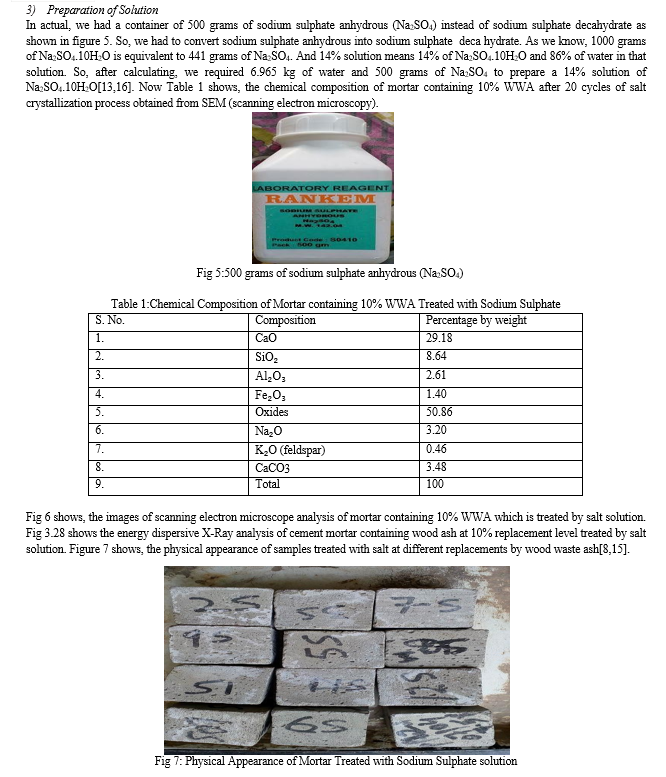
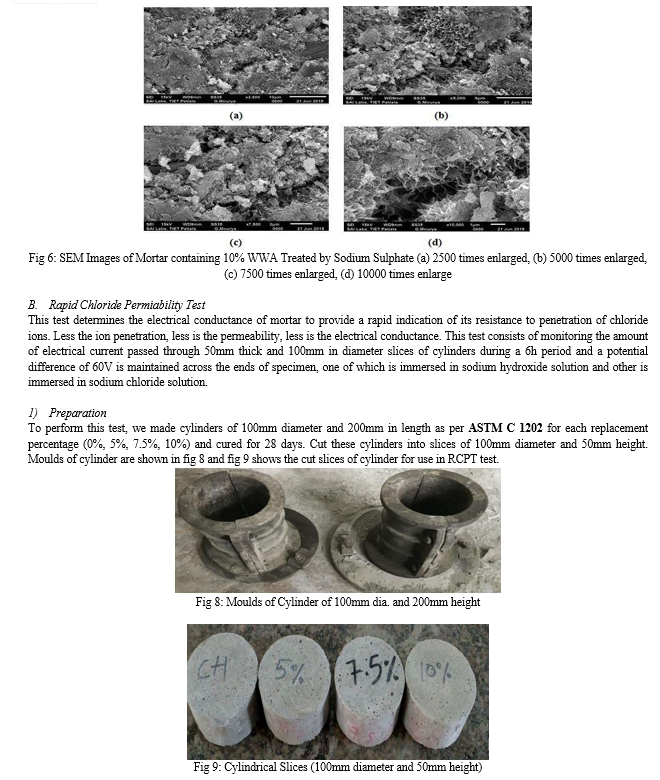
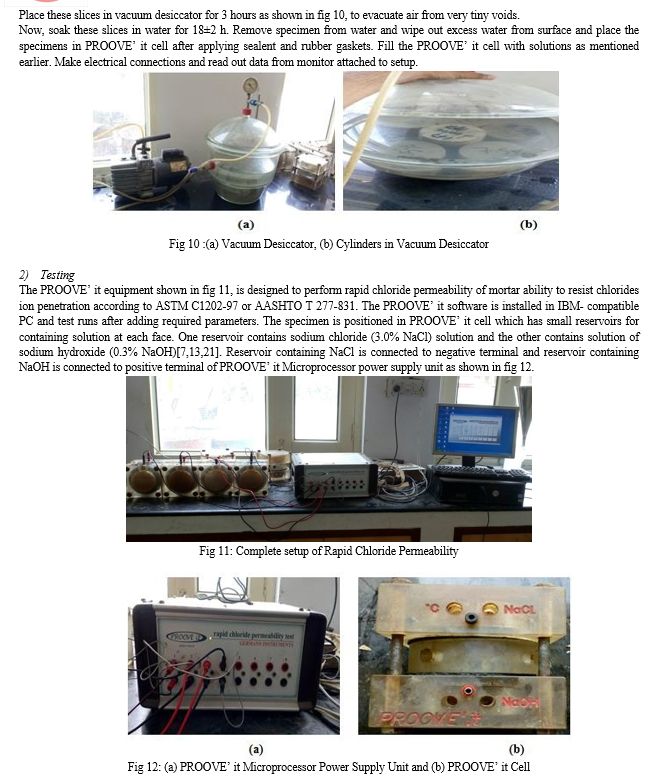


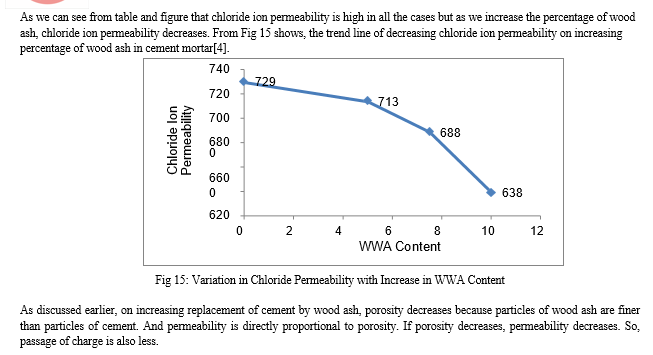
Conclusion
On the basis of results and discussion following conclusions are drawn: 1) Workability decreases with increase in replacement percentage of wood ash. 2) On treating with thermal cycling and salt attack, there is a decrease in weight of samples as well as well as decrease in compressive strength as compare to untreated samples. 3) From the test results, it is clear that chloride ion permeability is high for all replacement percentages. But it is also concluded that chloride permeability decrease with increase in percentage of wood ash. Chloride ion permeability at 5% replacement is 1.37% of control mix and at 7.5% replacement, it is 5.63% of control mix while at 10% replacement level, it is about 13.86% of control mix. 4) As wood ash contains more amount of calcium oxides which are soluble in water and leached out and further react with sodium sulphate. That is why, on increasing the percentage of wood ash, loss in weight as well as loss in compressive strength. 5) chloride ion permeability is high in all the cases but as we increase the percentage of wood ash, chloride ion permeability decreases. 6) If silica content is more, more is the formation of C-S-H gel and more is the strength. But, in case of wood ash, silica is present in negligible amount which reduce the formation of C-S-H gel
References
[1] Abdullahi M. Characteristics of wood ash/OPC concrete. Leonardo Electronic Journal of Practices and Technologies2006;8:9–16. [2] Mobili, A. Belli, C. Giosuè, T. Bellezze, F. Tittarelli, Metakaolin and fly ash alkali- activated mortars compared with cementitious mortars at the same strength class, Cem. Concr. Res. 88(2016). [3] Ellinwa AU, Ejeh SP, Akapabio IO. Using metakaolin to improve sawdust ash concrete.ConcrInt 2005. [4] Ellinwa AU, Ejeh SP. Effects of incorporation of saw dust incineration fly ash in cement pastes and mortars. J Asian Architect Build Eng2004;3(1):1–7. [5] Ellinwa AU, Mahmood YA. Ash from timber waste as cement replacement. Cement Concr Compos2002;24:219–22. [6] Greene TW. Wood ash disposal and recycling source book. Prepared for the coalition of Northeast Governors by OMNI environmental sources. Beaverton, Oregon;1988. [7] Horaskulthai V, Phiuvanna S, Kaenbud W. Investigation on the corrosion resistance of bagasse rice husk wood ash blended cement concrete by impressed voltage. Construct Build Mater2011;25(1):54–60. [8] Indian Standard Ordinary Portland Cement, 43 grade – Specification, Bureau of Indian Standards, ManakBhawan, 9 Bahadur Shah Zafarmarg, NewDelhi. [9] Naik TR, Kraus RN, Siddique R. CLSM containing mixtures of coal ash and a new pozzolanic material. ACI Materials Journal2003;100(3):208–15. [10] Naik TR, Kraus RN, Siddique R. Demonstration of manufacturing technology for concrete and CLSM utilizing wood ash from Wisconsin. Report no. CBU-2002-30. Report for year 1 activities submitted to the Wisconsin Department of Natural Resources, Madison, WI, for Project # 01-06 UWM Center for By-Products Utilization, Department of Civil Engineering and Mechanics, University of Wisconsin-Milwaukee, Milwaukee; 2002.p.124. [11] RajammaRejini, Ball Richard J, Tarelho Luis AC, Allen Geoff C, Labrincha Joao A, Ferreira Victor M. Characteristics and use of biomass fly ash in cement based materials. J HazardMater2009;172(2009):1049–60. [12] SiddiqueRafat. Utilization of wood ash in concrete manufacturing.ResourConservRecycl 2012;67:27–33. [13] Udoeyo FF, Dashibil PU. Sawdust ash as concrete material. J Mater CivEng 2002;14(2):173–6. [14] Udoeyo FF, Inyang H, Young DT, Oparadu EE. Potential of wood waste ash as an additive in concrete. Journal of Materials in Civil Engineering2006;18(4):605–11. [15] Vassilev SV, Baxter L, Anderson LK, Vassileva CG. An overview of the chemical composition of biomass. Fuel2010;89:913–33. [16] Wang S, Miller A, Llamazos E, Fonseca F, Baxter L. Biomass fly ash in concrete: mixture proportioning and mechanical properties. Fuel2008;87:365–71. [17] W. Yao, H. Liu, Y. Xu, K. Xia, J. Zhu, Thermal degradation of dynamic compressive strength for two mortars, Constr. Build. Mater.136 (2017) 139–152. [18] Ajit, I.A khan,M Z Khan, et.al , The effect of low Reynolds number on coefficient of S-type pitot tube with the variation in port to port distance, Materials today proceedings 45P9(2021) pp.7810--7815. [13] Ajit, Iqbal Ahmed Khan(2020). [19] Experimental work on the low Reynolds number behaviour of 2-hole offset probes.International Journal of Engineering and Advanced Technology(IJEAT).449-454 [20] Ajit , I A Khan(2022) The Experimental analysis on effect of low Reynolds number on probe coefficient having different-2 intertube spacing of S-type probe. \", International Journal of Emerging Technologies and Innovative Research (www.jetir.org), ISSN:2349-5162, Vol.9, Issue 4, page no.a604-a610, April-2022 [21] Ajit, M.z Khan, et.al ,The impact of low Reynolds number on coefficient of probe at different-different angle of S-type pitot tube,Materials today proceedings 46P15(2021) pp.6867-6870. [22] Rahul Gupta , Ajit Singh ‘’ To Study and Analysis on Performance of Regenerative Breaking System’’ International Journal of Emerging Technologies and Innovative Research (www.jetir.org), ISSN:2349-5162, Vol.10, Issue 3, page no.d518-d523, MarchS-2023 [23] Ajit Singh, Rahul Gupta et.al. “Investigation the Effect on Coefficient of filled and unfilled port to port dimension with plaster of paris of 2-Holes offset probe”International Journal for Research in Applied Science and Engineering Technology(IJRASET),ISSN:2321-9653,Volume 11,Issue 3,March 2023,page no.-2144-2151.
Copyright
Copyright © 2023 Shivangi ., Varun Kumar Sikka, Ajit Singh, Rahul Gupta. This is an open access article distributed under the Creative Commons Attribution License, which permits unrestricted use, distribution, and reproduction in any medium, provided the original work is properly cited.

Download Paper
Paper Id : IJRASET54869
Publish Date : 2023-07-20
ISSN : 2321-9653
Publisher Name : IJRASET
DOI Link : Click Here
 Submit Paper Online
Submit Paper Online

